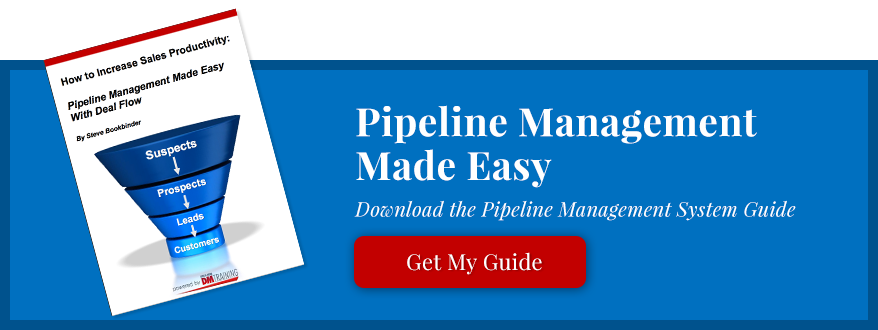How to Gain a Competitive Advantage through Pipeline Management
Do you find yourself constantly searching for new ideas and strategies about how to gain a competitive edge or advantage over your competitors? You are not alone. But search no more, we’ve got a sales system that will help you achieve sales success all year long.
Pipeline Management is a competitive sales management system that teaches essential sales strategies, tactics and habits to support your ideal sales pipeline.
Let’s break this down into 4 parts:
- Competitive Advantage
- Set Points
- Sales Culture
- Focus
Are you looking for a planning tool to help you streamline your pipeline management?
We can help!
Competitive Advantage
When I talk about Pipeline Management, the majority of sales people and sales managers stop me and say, “Steve, we already know that. We already know about managing our pipeline.” Are they sure? I wonder if they are actually confusing monitoring a pipeline with managing themselves in order to produce the right pipeline.
There is a difference.
For example: A warning sign that you’re merely monitoring your pipeline rather than managing it is when a salesperson looks at their pipeline and the only take-away they get is “oh, wait a minute, now I remember I am supposed to call the XYZ company. I’m glad I spotted them in my pipeline.” If that’s the only take away they have, that’s a clear sign they are monitoring their pipeline.
Managing your pipeline is a completely different thing. Managing your portfolio of prospects that are likely to close on schedule is about organizing your work life, prospecting right and selling right in order to create the right prospect base needed for you to hit your goals. If you’re not managing your sales activity, your prospecting, your sales strategies and tactics, everything associated with selling that gives you that pipeline you need to hit those goals, you’re not really managing anything. What you’re supposed to do is look at your pipeline and immediately think “what is my ideal pipeline supposed to look like?” And then by comparing the ideal picture to your actual pipeline you can make changes to make my real pipeline come closer to the ideal. That's managing a pipeline.
Set Points
Now, if we really want to manage our sales pipeline efficiently, then we must manage four points. These are four specific set points that managers, as well as sellers, need to keep a close eye on. What are those points?
First Appointment
A first appointment to begin the sales process is set! This could be either the first meeting with a new or revived lead or it is the first meeting with an existing customer to discuss renewing or upselling. At this stage, we should know the percentage of scheduled First Appointments that result in qualified “prospects” as well as have enough scheduled first appointments to meet selling needs, specifically backfilling the 25% column, which is our next set point.
25%
We have a mutually agreed upon scheduled next step! They are interested in hearing more of what we’ve got to say. At this stage, we’ve already had our first appointment and now we are working on information gathering and advancing the sale to the next stage. Remember, prospects will either advance or fallback, we must have enough prospects at this 25% stage to backfill both our 50% and 90% column.
50%
We are about to get a decision soon! At this stage of the game, there is a 50% chance the decision will go our way. We can help our chances by confirming that we’ve gathered the correct information. There are four pieces of information that need to be confirmed, which are: Person (or People), Proposal, Budget, and Timetable. It’s important for us to have this information so that if the sale moves forward, we have a clear picture of who is involved, what deliverables are needed, and the timeline for implementation.
90%
These four set points are guidelines to help us properly prepare and accurately diagnose/assess our current sales pipeline, which ultimately helps us respond accordingly and take the steps necessary to meet our ideal pipeline picture and goals. Remember, the goal of each salesperson is to become self-correcting.
Sales Culture
Successful sales cultures have two important qualities. They have a shared sense of mission and they have a shared language. Instituting the Pipeline Management System will help you achieve these two qualities and establish the right sales culture you need to stay ahead of the competition. For example, each salesperson should share the same meaning when it comes to the inspection methodology and overall sales process. If we’ve all agreed upon a shared sales process and language then it will be easier to make sure we are on track to hit our goals. Think of the Pipeline Management System as your sales GPS, always making sure you stay on course.
Focus
After implementing the Pipeline Management System, one of the first things that will be obvious is a new found visibility into sales activity. How? Why? Because this system forces sellers to think about their own sales activity and the overall impact their activity has on the bottom line. It helps the seller think about and focus on things like: how they prepare for meetings, whether they are properly qualifying, and are they asking for the right next step. Are they gaining the right information needed for presenting, negotiating, and closing? And finally, for all the sales managers out there: this system it will help you coach your team more effectively because you will know exactly where they need help and how you can have the greatest impact. That’s what happens when you fully implement the Pipeline Management System.
Are you looking for a planning tool to help you streamline your Pipeline Management?
Download our eBook for insight into how you can increase sales productivity!

About Steve Bookbinder
Steve Bookbinder is the CEO and sales expert at DMTraining. He has delivered more than 5,000 workshops and speeches to clients all over the world and has trained, coached, and managed more than 50,000 salespeople and managers. Steve continuously refreshes his training content to reflect his latest first-hand observations of salespeople across industries and regions. Through him, participants in his workshops and coaching sessions learn the best practices of today’s most successful sellers and managers across industries. Steve understands that sales is a competitive game. To outperform competitors and our own personal best results, we need to out-prospect, out-qualify, out-present and out-negotiate everyone else, not merely know how to sell. Through his specialty programs in Pipeline Management, Personal Marketing, Great First Meetings, 2nd-level Questioning, Sales Negotiating, and Sales Coaching, Steve trains sales teams to master the skills they need to overcome the challenges they face in today’s world… and keep improving results year over year.





